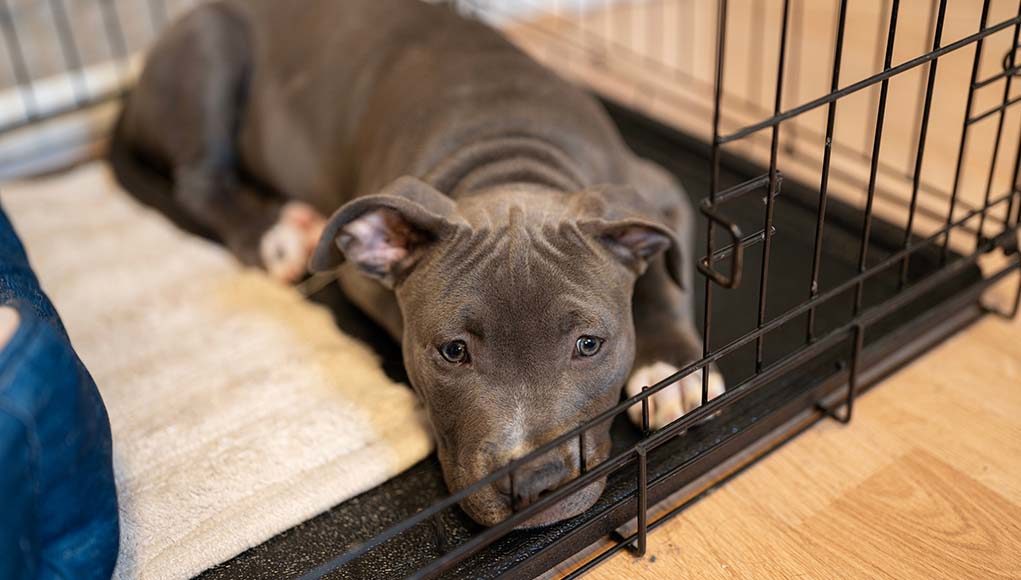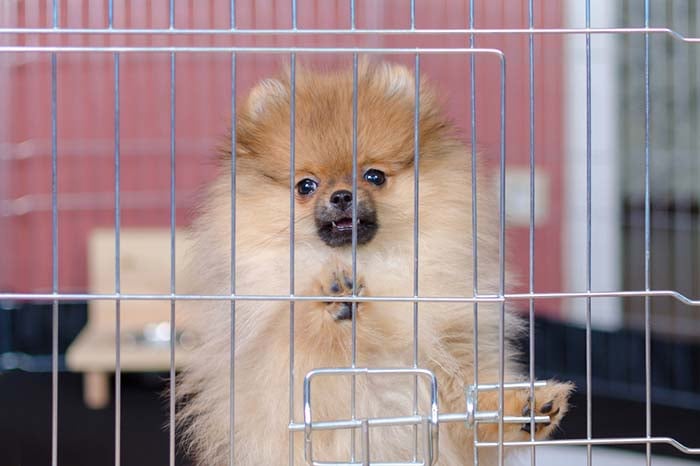You've just bought a dog crate for your pet where they can spend time while you're at work.
You chose the right size, color and material, you managed to get the dog willingly go into the crate, but just before you close the door, you hear the dog crying or barking.
Dog Crates: Prejudices, History and Facts
There's a divide between dog owners: those that strongly believe in using dog crates, and those that think crating a dog is a cruel practice that brings distress to a dog, associating crates with jails, confinement or inhuman treatment.
There's truth on both sides.
However, when it comes to dog owners in the U.S., many assume that all dogs should love crates, and that crating a dog is a simple and straightforward practice of placing a pet inside a crate and closing the door. Then, if they hear a dog whining in crate, something must not be right with the dog.
That's a wrong way to think about it.
Here's the truth: crating a dog is a very American practice that is not well-liked in many other parts of the world.
The myth that dogs are den-dwelling animals was never based on any compelling evidence but some poorly structured observational studies.
In fact, just like with many other “truths”, it was invented with an advertisement.
In the 80s, dog crates in America were becoming a thing, and at some point, newspaper has put out this pamphlet, called “A Pet Owner’s Guide To The Dog Crate“.
This was more or less the beginning of the “dogs are den animals” myth. It was further accelerated after companies saw potentials for profits in selling dog crates, and kept pushing this idea.
 However, while “dogs are den animals” myth is not true, the use of crates did teach us something about modern canines.
However, while “dogs are den animals” myth is not true, the use of crates did teach us something about modern canines.
Even though neither dogs nor their wolf ancestors were den dwelling animals by nature, studies with domesticated dogs of today showed that they have evolved to seek out dens, especially in certain cases like whelping.
When properly introduced and used, a dog crate can actually serve as a familiar and safe place of comfort and security for the dog.
At the same time, a crate should not be used as a way of correcting behavioral problems or as punishment for the dog; it's not a shortcut, and not an “easy way out” of training a dog correctly.
Generally, after the proper crate training phase is finished, dogs associate it with a clean environment where they sleep or relax, and where they won’t be bothered. Using a dog crate also helps owners with training their dogs and structuring a routine.
That said, a dog should never spend more time than necessary in a crate.
There's a right and a wrong way to go about crate training a dog, and if you choose to use it, make sure you've properly introduced the crate to your pet.
As mentioned above, dog crates are viewed with such positiveness mostly in the U.S., while in some other parts of the world, like Finland, dog crates are illegal (they're only allowed for transpiration of the animal).
So when you hear dog whining in crate, first ensure that you're not doing anything else wrong: the crate is correct size and type, it's comfortable, you have properly crate trained your pooch, and by now you know that typically they enjoy being in crate.
If all of those are true, and the dog whining in crate still, here are some possible reasons why.
5 Reasons for Your Dog Whining In Crate
1. Not a Good Fit
The crate may not be a good fit for your dog. It may be too small, and the dog needs space to stand up freely without bumping their head against the ceiling and space to turn around. Make sure you measure your dog appropriately.
Buying a crate that's too big isn't good either; it defeats the purpose of your dog having their own corner.
If they have too much space, they'll generally treat it the same way they treat a room, and may even pick a spot to go potty in one of the corners of the crate.
Next up is the type of the crate. There's several different ones, including soft sided ones, plastic, metal, and wooden crates. They all have their pros and cons, so consider if there may be an issue with that.
For example, maybe you got a soft crate and its material has a toxic “new” smell to it. Or, you bought a wooden crate and it's just doesn't feel like a crate to your dog but more like you're confining them into a cupboard.
2. The Dog Misses You
Especially in the beginning, the crate may seem like a detachment of your dog from you.
You will recognize this if the dog stops crying when you come closer to a crate or start playing with them even without opening a gate.
However, if you properly introduced the crate and trained your pooch to stay inside, this should not be happening.
The animal must already understand that you'll be leaving the general area of the crate, and that should be fine with them. If that's not the case, you may need to take a step back and do crate training again.
3. The Dog Is Bored
If your dog is energetic and lively, jumping around and racing through your house the whole day, they may not be ready to be confined in a small space.
They're still full of energy they need to expend.
You will notice this to be the case if your pooch displays destructive behavior, chewing the crate bars, dog whining in crate and excessive barking, or going in circles vigorously.
It's a sign for you to either provide them with interactive toys and hopefully that'll settle the dog, but if not, you may have to take them out, then play with and exercise the dog.
4. The Dog Needs a Bathroom Break
Your dog's needs might be the cause of whining. Especially if it's a puppy, they won’t be able to hold their bladder for too long. Age is very important consideration for crating a dog, and when dealing with puppies, consider how often they need to be let out for potty time.
While using a dog crate can help with potty training after you develop a schedule, during the learning process you will not know how long your puppy can hold it in for, and it'll take time to figure that out.
If the puppy starts whining, take them out for a potty break. If you let the dog cry in the crate, especially if it's a full bladder that causes them to whine, the puppy will begin developing negative feelings towards the crate.
5. Separation Anxiety
Separation anxiety is a very possible cause of dog whining in crate, which means your pooch simply cannot handle being anxious whenever you are gone from the room, or they don't see or hear you around.
Assume this is the cause if they're visibly anxious whenever you step out, regardless of the place.
To prove this, let the dog out of the crate and start leaving the house. If your pet's reaction is exaggerated such as excessive and loud barking, whining and scratching, this can be the reason behind it.
What to Do When Your Dog Whines In Crate
1. Replace the Crate
If your dog feels uncomfortable in a crate, replace it. There are many different types available, and you can find something that will be a better fit for your pooch: plastic, metal and soft sided crates, which can even fit into your interior design.
The size can be a bit tricky, especially with a growing puppy, but you can find adjustable crates, where you can limit the space your dog has inside using a crate divider.
2. Make It More Comfortable
If dog whining in crate is caused by anxiety and your pup missing you, keep them in a crate for a shorter amount of time and gradually prolong it bit by bit. This will be less stressful for your dog.
Place toys inside the crate which will help the adjustment process, and for especially anxious dogs, use separation anxiety toys.
You can throw in a piece of your clothing or blanket that smells like you to ease the anxiety as well. There are many types of fluffy mats or dog blankets to make the crate even cozier for the pup.
3. Exercise Your Dog
When a dog is whining in a crate, seem agitated, unsettled and looking for things to destroy and chew through because they're too energetic or bored, exercise and play with them more before crating the dog.
The easiest way is to make it a habit to take your pooch for a much longer walk right before you are about to put them in the crate.
Maybe play a quick game of fetch at the end of the walk, too. This may not always be necessary as the dog keeps getting used to the peaceful time inside the crate.
4. Take the Dog to the Vet
In the case you suspect that dog whining in crate is caused by some health issue or psychological problem like separation anxiety, the best option is to avoid crating the dog for now and take them to the vet.
If veterinarian finds a medical issue that needs treatment without the use of the crate, and you cannot constantly monitor your pet during the treatment process, see about leaving them with your friends or family while at work, or hire a dog walker.
5. Stop Using the Crate
After you've picked the right type and size of the crate, made proper introductions and crate trained your adult dog, checked with the vet that no health issues are causing the dog whining in crate and this issue simply won't go away – stop using the crate altogether.
Remember, dog crates are not a “normal thing” for pets. Some dogs love them and see a crate as a zone of peace and quiet, while others may be uncomfortable no matter what.
They're not den dwelling animals and this should not be enforced on your dog.
If you still need to confine your pooch, consider using pet gates or playpens instead.
15These will give your pet more freedom and space to play around in, and they won't feel as restricted as they would in a crate.
READ NEXT: The Best Dog Crates for Training
Disclosure: We may earn affiliate commissions at no cost to you from the links on this page. This did not affect our assessment of products. Read more here and find full disclosure here.
















